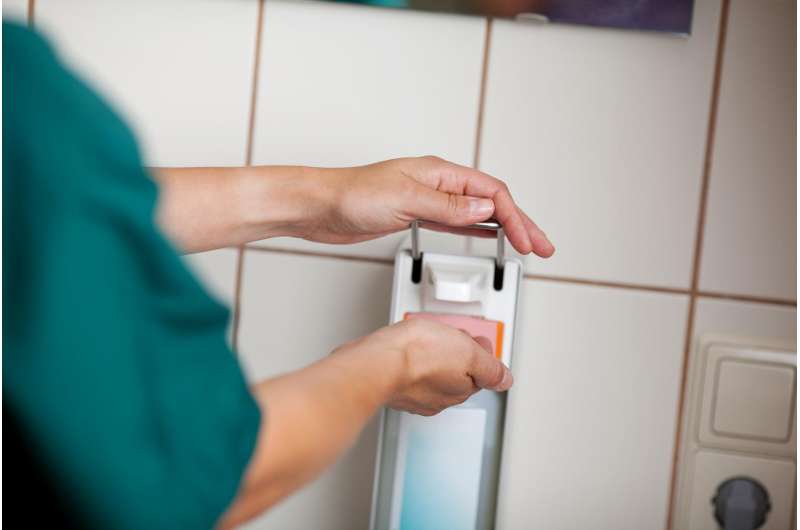Motivation via monitoring: Research from Olin Business School shows that electronic monitoring of hand-washing compliance in hospitals works well -- for a while. Credit: Washington University in St. Louis
In a myriad of workplace settings, standard processes are key to a successful operation, ensuring efficiency and safety. For these processes to work, employees must comply. But what's the best way to go about enforcing that compliance, and sustain it?
New research from Olin Business School at Washington University in St. Louis shows that motivating compliance with standard processes via electronic monitoring can be a highly effective approach, despite concerns about employee backlash. However, the research also highlights that managers cannot simply "monitor and forget," and that a long-term plan for supporting the retention of monitoring is critical. The findings were published online May 5 in Management Science.
Hengchen Dai, assistant professor of organizational behavior at Olin, along with co-authors Bradley A. Staats and David Hofmann from the University of North Carolina at Chapel Hill and Katherine L. Milkman from the University of Pennsylvania's Wharton School, studied compliance with hand-hygiene guidelines among more than 5,200 caregivers at 42 hospitals for more than three years.
They collaborated with Proventix, a company that uses a radio frequency-based system to track whether health-care workers wash their hands. More than 20 million hand-hygiene opportunities—incidences when hand hygiene is expected—were captured; each with the potential to prevent, or spread, a hospital-borne illness or infection.
"Maintaining high compliance with standard processes is a challenge for many industries," Dai said. "We examined hand-hygiene compliance in hospitals because this is a setting where consistent compliance is extremely important in an effort to eliminate hospital-acquired infections. This is an area where improvements can, and should, be made."
Dai and her co-authors found that on average, electronic monitoring resulted in a large increase in hand-hygiene compliance during their study period. Interestingly, compliance initially increased, and then gradually declined, after approximately two years. When electronic monitoring was stopped, hand-washing rates dropped, suggesting that hand-hygiene habits weren't formed.
In fact, researchers discovered that compliance rates for hand-washing dropped to below the levels seen before the monitoring began, a finding that is surprising to both the researchers and health-care practitioners.
"While we thought decreased compliance after the monitoring could perhaps be a possible outcome, we were still somewhat surprised to see the result," Dai said. "We based our prediction on past research about 'crowding out,' whereby caregivers' internal motivation for compliance may have been replaced by external forces associated with monitoring, such as the fear of penalties or punishments for not washing their hands.
"When the external stimulus of monitoring was removed, their compliance behavior declined below the initial level as both the external forces and internal motivations were gone," she said. "We do not have the data to get into the underlying psychology, but it is certainly worth examining in future research."
While the findings focused on the health-care profession, Dai said all managers should take note, no matter their field. While electronic monitoring is an important motivation and compliance tool, it's a single piece of a larger strategy.
"Individual electronic monitoring is one tool managers can use to dramatically improve standardized process compliance, but that it is not a panacea," Dai said. "Managers looking to build process compliance must think about how electronic monitoring fits within a broader system encompassing not only technology, but also norms, culture and leadership.
"Managers should not 'monitor and forget,' " Dai said.
More information: Bradley R. Staats et al, Motivating Process Compliance Through Individual Electronic Monitoring: An Empirical Examination of Hand Hygiene in Healthcare, Management Science (2016). DOI: 10.1287/mnsc.2015.2400
Journal information: Management Science
Provided by Washington University in St. Louis




















